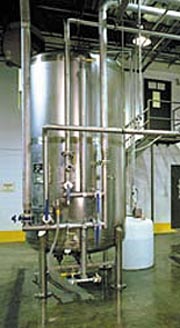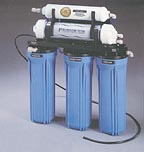
The process got a major boost in the early 1900s with the development of carbon activation, which increased the carbon's effectiveness exponentially. Activated carbon filters are extremely effective at removing organic chemicals that can cause color, odor and taste problems in water. The raw carbon used in these systems comes from manufactured coal, as well as wood, peanut shells and coconut shells. Coconut shells are popular because they are a renewable resource, produce good tasting water and are quite effective at removing trihalomethanes (THMs).
Carbon filtration generally can be used to remove chlorine, pesticides, herbicides, industrial chemicals, THMs, polychlorinated biphenyls (PCBs) and halogenated compounds. Carbon filters remove chemicals by the process of adsorption, whereby a particle or molecule adheres to the surface of a substance, usually due to a molecular attraction. As water comes into contact with the carbon, the organics present in the water adhere to the carbon. Because the adsorption process depends on contact, the more surface area the carbon has available, the more contaminants it can adsorb. This is where the activation of the carbon comes into play.
Two Basic Types
Granulated carbon is activated by heating it so that it becomes crystallized, and then heating it again with air or steam to create thousands of tiny pores in all the grains. All those little pores mean that a single pound of granular activated carbon has a total surface area of about 125 acres - extremely adsorptive. Granular activated carbon treatment is rather basic - the main element being a tank full of carbon through which the water flows. Starting at the top of the tank, the water loses its contaminants to the carbon as it flows downward through the increasingly clean activated carbon granules.
Another type of carbon filter is designed in block form. These filters are made using an extrusion process that results in a filtering product that has exceptional porosity, dimensional uniformity and strength. Water is forced through the carbon (compared to around the carbon with the granular system), allowing for even greater adsorption rates due to increased contact taking place with the carbon.
More Differences
In keeping with the water conditioning credo that there are no one-size-fits-all solutions, there are many carbon filtration systems from which to choose. Their effectiveness in the adsorption process is dependent upon variables such as the kind of carbon used in the filter, the filter design, its age, the contaminants being filtered, the rate of water flow through the carbon filter and how the filter is maintained.Different raw materials and different manufacturing processes produce carbon filters of varying porosity and chemical properties that make them more or less attractive to certain contaminants.
Some filter designs work better on certain contaminants than others, often depending on their concentration. You need to know how a filter will perform for specific chemicals at different levels of contamination.
Adsorption effectiveness normally increases as the temperature and pH of the water decreases. Lower water temperature and pH generally means that the organic contaminants are in a more adsorbable state.
The adsorption process also is affected by the amount of time that the water is in contact with the carbon. The more carbon present and the slower the flow rate of the water, the more contaminants can be intercepted.
Eventually the carbon filter becomes saturated with contaminants and can no longer do its job. Contaminants that lead to taste and odor problems make this obvious. But in the case of other contaminants, it's not as easy to know when a filter needs to be replaced. A common mistake is depending on chlorine tests to determine whether a new filter is needed. The filter probably is letting plenty of other contaminants through before the chlorine would be detected.
The useful lifetime of the filter is determined by flow rates (normal and peak), residence volume of the unit, carbon surface area-to-volume ratio, sediment, turbidity and the concentrations of the various contaminants in the water. For average household use, a general rule of thumb is to replace the filter after six months or 1,000 gallons of filtered water. In industrial applications, filters can last anywhere between two weeks and six months. While general recommendations can be helpful and provide starting-point guidelines, the only way to know for sure is to conduct the appropriate tests.

Cautions to Heed
Carbon filtration is not to be depended upon to remove contaminants such as dissolved solids, fluorides, heavy metals, mineral salts and nitrates. Elimination of these contaminants requires the services of reverse osmosis, distillation or ion exchange systems.Carbon filters can be a breeding ground for bacteria. The organic chemicals that are adsorbed to the carbon are a food source that allows bacteria to thrive. The bacteria eventually makes its way through the filtration process, in effect defeating the purpose of the water treatment. Some of the bacteria can cause disease in humans and animals - most don't, however. Some manufacturers have added silver compounds to carbon filters, claiming that the silver will take care of the bacteria - another example of something that works in the lab but not in the real world.
A drawback to the granulated carbon filter systems is the granules' tendency to channel - the water creates pathways, diminishing contact with the carbon and, therefore, the system's effectiveness. Also, carbon beds compact over time; they may require occasional backwashing.
All carbon must eventually be disposed of; it can only be regenerated a limited number of times. Depending on its characteristics, the used carbon might need to be handled as a hazardous waste, adding to expense and liability.
Carbon filters are but one part of an overall system, and all parts must work together to get the job done right. When correctly designed, installed and maintained, and used in combination with other treatment technologies, carbon filtration can be extremely effective in treating water.
Report Abusive Comment